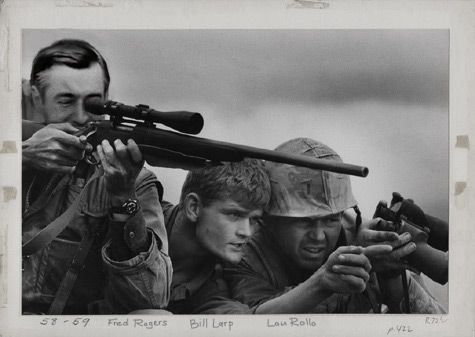
Urban legends are the kind of stories told around a campfire or under a sofa cushion fort at a sleepover. These modern folktales are usually pretty scary—and of course, the storyteller swears what they’re saying is a true story they heard from a friend, who knows someone who knows the victim.
From what inspired Candyman or a bizarre videogame to the tales about alligators in the sewers and the temporary tattoos spiked with LSD, we’re breaking down the origins of the weirdest five urban legends in this list!

CANDYMAN
This year, director Nia DaCosta will be releasing a new vision of Candyman, the popular 1992 horror hit about a vengeful spirit who is summoned by saying his name five times. In one of the movie’s most terrifying scenes, the villain bursts through a medicine cabinet in the bathroom to attack his victim.
While Candyman himself isn’t an urban legend—the character is based on a short story by Clive Barker—the idea of a killer attacking you through a bathroom mirror is rooted in fact. In 1987, a woman named Ruth McCoy was killed when a burglar crawled through a false wall behind her medicine cabinet, which was put there to make it easier to assess plumbing issues in the Chicago Housing Authority project.
Like many famous modern myths, there can be a good deal of truth in the fiction. Whether intentional or a strange coincidence, two of the characters in the 1992 film actually shared the last name McCoy with the real-life victim.

TEMPORARY TATTOOS SPIKED WITH LSD
In the 1980s, some kids and their parents had second thoughts about temporary tattoos when it was rumored that some of the stickers were spiked with LSD. Adults were warned about tattoos that featured blue stars or cartoon characters.
The concept of contaminated sticky stuff goes back to at least the 19th century. In 1885, The Lancet gave an account of a man who habitually took large quantities of morphine.
One day the opiate enthusiast licked the adhesive surface of an envelope and sent it off. The recipient opened the envelope and then decided to lick it shut again. As The Lancet described it, “The mere touch of the tongue of the taker of morphia had rendered the gum intensely nauseous. If this could happen, obviously there must be grave peril of the transmission of disease by such means.”
Many years later, police warnings over blotter acid mentioned kids could be susceptible. This was misinterpreted to mean that kids had been exposed to acid. To date, no one with a temporary Care Bears tattoo has ever been unknowingly dosed with LSD.

ALLIGATORS IN THE SEWERS
Some of the most effective urban legends take familiar things and give them a sinister connotation. And while you may not have warm feelings about sewers, it is disturbing to think alligators might be lurking in them. This scenario stems in large part from writer Robert Daley’s 1959 book, World Beneath the City.
In it, Daley describes an eyewitness account from Teddy May, who was New York City’s superintendent of sewers. According to May, sewer workers had been telling him about alligators as far back as 1935, but he didn’t believe them. Eventually, May went down to see for himself and spotted several alligators averaging two feet in length. They appeared to be quite content, according to May. It was later said that he was prone to tall tales, so it’s a bit hard to separate gator fact from fiction.
Though there are reliable accounts of the occasional alligator in the sewer, according to The New York Times, New York’s Animal Care and Control rescues two to four alligators, crocodiles, or caimans a year, but they’re usually above ground—the bacterial load of your average sewage system makes it pretty inhospitable to alligator life. Beware, though—some animals, like rats, have been known to crawl through plumbing and into residential toilets.

FRED ROGERS WAS A SNIPER
The more famous you are, the more urban legends tend to circulate about you. And few people have had more tawdry rumors about them than Fred Rogers, the late and very much missed host of Mister Rogers’ Neighborhood. In the most persistent urban legend about Mr. Rogers, it’s said that he was a Navy SEAL or possibly a military sniper with confirmed kills. The reason he favored long-sleeved sweaters was supposedly to cover up his numerous tattoos.
In fact, Fred Rogers was a sharpshooting marine—but it was a different Fred Rogers. According to the screenwriters behind the recent Fred Rogers biopic, that Rogers used FredRogers.com for his security business for a brief period of time, and that’s likely what led people to confuse the two Freds.
That’s almost as silly as picturing Doctor Ruth Westheimer, the amiable sex therapist and media personality, as a trained sniper who was seriously wounded in a bomb blast. Or Julia Child serving in the Office of Strategic Services, a precursor to the CIA, during World War II. Except both of those stories are actually true. Maybe that’s why some people had no trouble believing Rogers also had a secret military past.

POLYBIUS
For years, gamers have traded stories about a strange arcade game titled Polybius. The all-black machine was said to be a CIA operation meant to study players or even induce strange physical effects—sort of like MK Ultra, the infamous mind control experiment, only this time with pixels. Polybius never existed—that we know of—but elements of the story are true.
In 1981 Portland, a video game player at an arcade contest drank too much soda and got sick during a 28-hour marathon gaming session. A few days later, news reports appeared saying federal authorities had raided Portland arcades to seize cabinets that had been declared gambling devices.
There was even an East German arcade machine from a few years later called Poly-Play, and some versions of the story credit Polybius to a mysterious German firm. Put all these elements together and you have a recipe for urban legend success.









































































































